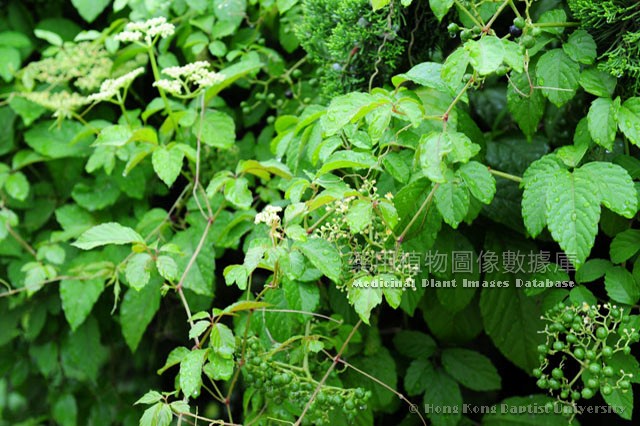|
Cayratia japonica (Thunb.) Gagnep.

|
English Name |
Japan Cayratia, Japanese Cayratia, Whitefruited Grape |
|
Latin name |
Cayratia japonica (Thunb.) Gagnep. |
|
Family & Genus |
Vitaceae, Cayratia |
|
Description |
Perennial herbaceous vines. Stem purple red, with longitudinal edges; branchlets sparsely pubescent or nearly glabrous; tendrils 2-3 fork-branched, opposite to leaves. Bird foot-shaped 5 leaflets compound leaves, alternate, central leaflets long-elliptic or elliptic-lanceolate, 2.5-4.5cm long, lateral leaflets elliptic, long-elliptic or narrow oval, 1-7cm long, apex acuminate, base cuneate or broad round, each side with 6-15 sparse serrations, lower part glabrous or slightly hairy; petioles 1.5-10cm long, lateral leaflets nearly sessile or with short stalks, central small petioles 0.5-2.5cm long, stipules triangular, caducous. Complex dichotomous cymes axillary, corymbose, peduncles up to 13cm long, glabrous or nearly glabrous; flowers yellow green, calyx butterfly-shaped, entire or wavy-lobed, petals 4, triangular broad oval, with papillary hairs outside; stamens 4, opposite to petals; floral disc developed, fleshy, 4 lobed, ovary trapped within floral disc. Fruits nearly spherical or ovate, nearly 1cm in diameter, black when ripe. Seeds 2-4, inverted triangular-ovate, pot-holes type of indentations on both sides of ventral extended upward from near base, across top of seeds. Flowering: March to August, fruiting: August to November. |
|
Distribution |
Growing in forest in valleys or thickets. Distributed in Henan, Shandong, Jiangsu, Anhui, Zhejiang, Fujian, Taiwan, Jiangxi, Hubei, Hunan, Guangdong, Hainan, Guangxi, Guizhou, Yunnan, Sichuan, Southeast Gansu and South Shaanxi. The medicinal materials are mainly produced in Jiangsu, Zhejiang, Jiangxi, Hunan, Guizhou, Sichuan, Fujian, Guangdong, Guangxi and etc. |
|
Part Used |
Medical part: whole plant or roots. Chinese name: Wulianmei. |
|
Harvest & Processing |
Cut canes or excavated roots in summer and autumn, removed impurities, well washed, cut into segments, sun-dried and used fresh. |
|
Chemistry |
Whole plant contains volatile oil consisting 30 components such as camphor, sabinene, alloaromadendrene, santalol, bornylacetate, piperitone, 1-eicosyne, decamethylcyclohexasiloxane, etc. Also apigenin, luteolin, lupeol, palmitic acid, araban, lymphatic temperament, potassium nitrate and amoni acid, etc. Roots contain alkaloid, tannins, amylum, gum and lymphatic temperament. |
|
Pharmacology |
Anti-viral, antibacterial and heat-dispelling, anti-inflammatory and effective on clotting and immune functions; toxic. |
|
Properties & Actions |
Taste bitter, sour, and cold in nature.Clearing heat, removing dampness; detoxifying and dispersing swelling. |
|
Indications & Usage |
Used for anthracia due to heat toxin, furunculosis, erysipelas, swelling and pain in throat, bites by snakes and insects, burns caused by hot liquids or fires, rheumatic arthralgia, jaundice, dysentery, whitish and turbid urine, hematuria.Oral administration: decocting, 15-30g; made as medicinal liquor or smashed to extract juice and prepared tea. External application: appropriate amount, smashed. |
|
Examples |
1. Erysipelas of the face: narrowleaf rockvine root , pestle and apply to the affected lesions.
2. Ecthyma: fresh Japan Cayratia leaves, pestle and apply to the affected lesions, wrap with wide cloth, change every other day. Or dry under the sun and grind into powder, each drug powder 30g, mix with pig fat 90g, pestle and prepare ointment, spread ointment onto paper, and apply to the affected lesions.
3. Mastitis: fresh Japan Cayratia, pestle and apply to the affected lesions. |
|

